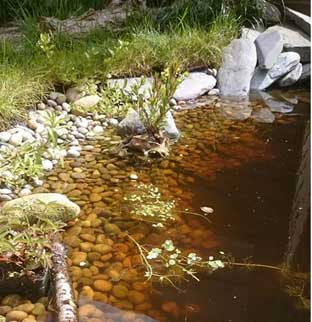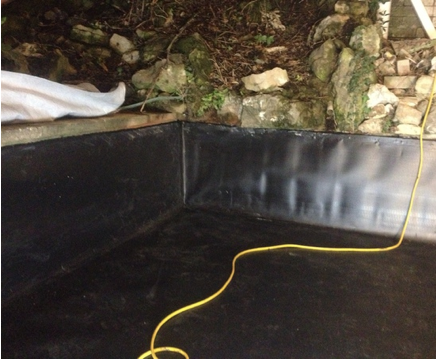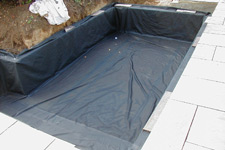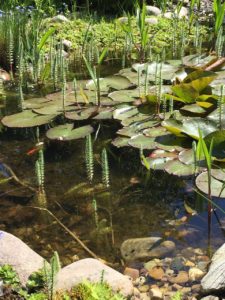Pond liners last many years if installed correctly. Most manufactures of rubber pond liners offer at least a 25 year guarantee provided the pond liner is installed above a protective underlay. For Butyl or Epalyn pond liners up to 100m2 in diameter the guarantee offered by Liners Online is life-time. Pond liners bigger than 100m2 are guaranteed for 25 years. Butyl pond liner, a 0.75mm thick synthetic rubber has been used to line ponds in the UK for over 40 years with great success and is still considered to be one of the best pond liners on the market.
Pond liners are essentially a waterproof fabric whose function it is to keep the water from seeping into the ground. Not all pond liners are made equal therefore it is advisable to check the guarantee terms and conditions before placing an order. The guarantee period is just a gauge on how long you can expect a pond liner to last. 
Types of pond liners
Pond liners vary in strength, flexibility and durability depending on what material they are made from:
- PVC pond liners – usually around 0,5mm thick. The liner is flexible, however it is not tear resistant so if the material is punctured, it may get worse over time. PVC pond liner will go brittle and crack if exposed to the sun over a period of time therefore correct installation and maintenance are essential. PVC can’t be easily repaired as most pond liner repair products cause the liner to go brittle around the area it is applied to leading to further cracks and leakages. Protecting it with an underlay liner is essential to help prevent leaks. PVC pond liners last around 20 years.
- Rubber pond liners – These liners can be further divided into EPDM (Epalyn) and Butyl, the latter of which has for long been considered one of the best materials by pond enthusiasts. EPDM, on the other hand, is less costly and has similar, if not slightly better characteristics than Butyl. Both pond liners are known to last upwards of 30 years. Should either puncture they can readily be repaired without a costly replacement.
- Preformed pond liners – they are of a predetermined size and shape that can’t be changed. Made of fibreglass or a rigid plastic with pros and cons to both types. Fibreglass is expensive but can be installed above or below ground level. Rigid plastic liners must be installed inside the ground to prevent them from flexing and cracking. A preformed pond will last upwards of 10 years. Ground movement can cause cracking with age so generally have a shorter life span than a flexible rubber pond liner.
Can a pond liner be installed directly on the ground?
Yes, you can however we don’t recommend doing so as this affects the guarantee on the liner. There is also a much higher probability the rough surface of the ground will puncture the pond liner. Liners Online supply a non-woven, mechanically bonded, needle-punched, Geotextile underlay. It offers high performance and provides a highly effective protective barrier between substrate and pond liner. We recommend that an underlay is used beneath all our pond liners, not only to help protect the pond liner from penetration by sharp stones and roots but also to reduce excessive localised stretching of the liner when ground settlement occurs over time.
In summary, a flexible PVC or rubber pond liner will last 20 years and more provided they are installed above a protective underlay, secured in place with appropriate edging material and protected from regular clawed animal visits. A well maintained and cared-for pond should give you years of pleasure.









 Formal ponds take inspiration from classic architecture. They are built to a symmetrical design where perfectly straight or arched lines are used to create the shape. Designs typically include square, rectangular and circular sides – or a combination of these to create an ornate design. Hexagonal formal ponds are less common but lends itself to a uniquely designed garden feature. Whether a formal pond is built at ground-level or raised above and supported by a retaining wall, the symmetrical shape is made water-tight by lining it with a protective underlay and pond liner.
Formal ponds take inspiration from classic architecture. They are built to a symmetrical design where perfectly straight or arched lines are used to create the shape. Designs typically include square, rectangular and circular sides – or a combination of these to create an ornate design. Hexagonal formal ponds are less common but lends itself to a uniquely designed garden feature. Whether a formal pond is built at ground-level or raised above and supported by a retaining wall, the symmetrical shape is made water-tight by lining it with a protective underlay and pond liner.
 us design is wanted, then a rubber pond liner can be hot-bonded together to give the same formal look as a box-welded pond liner. The most noted feature is that this type of liner is free from folds and creases giving a pond a formal, neat appearance. Butyl or Epalyn are used because they are very flexible, durable and can be readily manipulated into a vertical sided shaped pond.
us design is wanted, then a rubber pond liner can be hot-bonded together to give the same formal look as a box-welded pond liner. The most noted feature is that this type of liner is free from folds and creases giving a pond a formal, neat appearance. Butyl or Epalyn are used because they are very flexible, durable and can be readily manipulated into a vertical sided shaped pond.
 cleaning
cleaning 
 o try a redesign with steep sides, greater depth and inclusive of rocks and bolders positioned in such a way as to create a place for fish to hide when they feel threatened.
o try a redesign with steep sides, greater depth and inclusive of rocks and bolders positioned in such a way as to create a place for fish to hide when they feel threatened.
